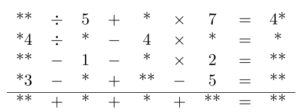Problems
Thirty girls – 13 in red dresses and 17 in blue dresses – led a dance around the Christmas tree. Subsequently, each of them was asked if her neighbour on the right was in a blue dress. It turned out that those girls which answered correctly were only those who stood between two girls in dresses of the same color. How many girls could have said yes?
Here’s a rather simple rebus:
\(EX\) is four times larger than \(OJ\).
\(AJ\) is four times larger than \(OX\).
Find the sum of all four numbers.
In a group of friends, each two people have exactly five common acquaintances. Prove that the number of pairs of friends is divisible by 3.
Find the largest value of the expression \(a + b + c + d - ab - bc - cd - da\), if each of the numbers \(a\), \(b\), \(c\) and \(d\) belongs to the interval \([0, 1]\).
The White Rook pursues a black horse on a board of \(3 \times 1969\) cells (they walk in turn according to the usual rules). How should the rook play in order to take the horse? White makes the first move.
In a set there are 100 weights, each two of which differ in mass by no more than 20 g. Prove that these weights can be put on two cups of weighing scales, 50 pieces on each one, so that one cup of weights is lighter than the other by no more than 20 g.
Peter bought an automatic machine at the store, which for 5 pence multiplies any number entered into it by 3, and for 2 pence adds 4 to any number. Peter wants, starting with a unit that can be entered free of charge to get the number 1981 on the machine number whilst spending the smallest amount of money. How much will the calculations cost him? What happens if he wants to get the number 1982?
A game with 25 coins. In a row there are 25 coins. For a turn it is allowed to take one or two neighbouring coins. The player who has nothing to take loses.
Replace each letter in the diagram with a digit from 1 to 9 so that all the inequalities are satisfied,

and then arrange the letters in numerical order of their numerical values. What word did you get?
In the rebus in the diagram below, the arithmetic operations are carried out from left to right (even though the brackets are not written).
For example, in the first row "\(** \div 5 + * \times 7 = 4*\)" is the same as "\(((** \div 5) +*) \times 7 = 4*\)". Each number in the last row is the sum of the numbers in the column above it. The result of each \(n\)-th row is equal to the sum of the first four numbers in the \(n\)-th column. All of the numbers in this rebus are non-zero and do not begin with a zero, however they could end with a zero. That is, 10 is allowed but not 01 or 0. Solve the rebus.
